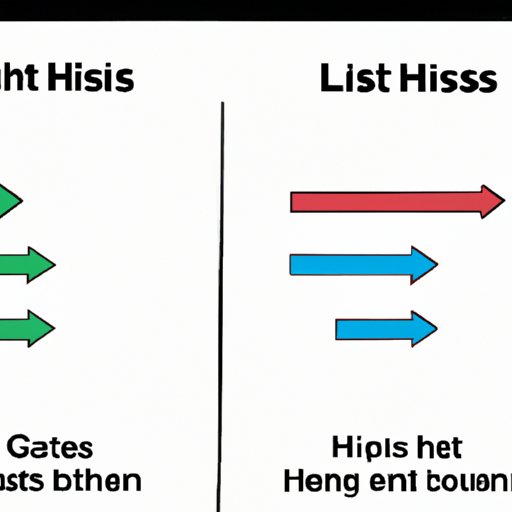Introduction
Increasing your heart rate through exercise is an important part of any fitness routine. But what are the best exercises to do so? High intensity interval training (HIIT) and low intensity steady state (LISS) exercise are two popular forms of exercise for increasing heart rate. Additionally, plyometrics, sprinting, resistance training, jump rope, swimming, and cycling can all be effective ways to increase your heart rate. In this article, we will explore which exercise increases your heart rate the fastest by comparing HIIT and LISS exercise, examining the benefits of plyometrics, investigating the role of sprinting, understanding the impact of resistance training, exploring the effectiveness of jump rope, analyzing the effects of swimming, and evaluating the benefits of cycling.

Comparing HIIT to LISS Exercise
HIIT and LISS exercise are two popular forms of exercise for increasing heart rate. HIIT involves short bursts of high intensity exercise followed by periods of rest or low intensity exercise. It typically involves doing exercises that require a lot of effort such as running, jumping, or lifting weights. HIIT is often used by athletes to improve their performance and by people trying to lose weight.
LISS exercise is a form of exercise that involves maintaining a steady pace at a moderate intensity for a prolonged period of time. This could include activities like walking, jogging, or biking. LISS exercise is often used by people who want to improve their overall cardiovascular fitness without putting too much strain on their body.
Both HIIT and LISS exercise have their advantages and disadvantages when it comes to increasing heart rate. Let’s take a look at some of the pros and cons of each type of exercise.
Advantages of HIIT for Increasing Heart Rate
The biggest advantage of HIIT is that it can help you reach higher levels of exertion in a shorter period of time. This means you can get more out of your workout in less time. HIIT also has the benefit of burning more calories than LISS exercise, which can help with weight loss goals. Finally, HIIT can help to improve your aerobic capacity, which is the ability of your body to use oxygen efficiently.
Disadvantages of HIIT for Increasing Heart Rate
The main disadvantage of HIIT is that it can be very intense and may not be suitable for everyone. It is also important to note that HIIT should not be done every day, as it can lead to overtraining and injury if done too often. Finally, HIIT requires a lot of energy and can be difficult to sustain for extended periods of time.
Advantages of LISS for Increasing Heart Rate
The biggest advantage of LISS exercise is that it is much easier to maintain for extended periods of time. This means that you can get a good workout in without feeling exhausted. LISS exercise is also less intense than HIIT, so it can be a good option for people who are just starting out with exercise or who do not want to push themselves too hard. Finally, LISS exercise can help to improve your overall cardiovascular fitness and can help to burn fat.
Disadvantages of LISS for Increasing Heart Rate
The main disadvantage of LISS exercise is that it takes longer to see results. It can also be difficult to stay motivated when doing LISS exercise for extended periods of time. Additionally, LISS exercise does not provide the same level of intensity as HIIT and may not be as effective for improving your aerobic capacity.
Examining the Benefits of Plyometrics for Increasing Heart Rate
Plyometrics is a form of exercise that involves explosive movements that involve both strength and speed. Examples of plyometric exercises include box jumps, burpees, and jump squats. Plyometrics can be a great way to increase your heart rate because it requires a lot of power and coordination.
Advantages of Plyometrics for Increasing Heart Rate
The biggest advantage of plyometrics is that it can help to increase both your strength and power. This can help to improve your overall athletic performance. Plyometrics can also help to improve your coordination, balance, and agility. Additionally, plyometrics can help to increase your heart rate quickly and effectively.
Disadvantages of Plyometrics for Increasing Heart Rate
The main disadvantage of plyometrics is that it can be difficult to learn the proper form and technique. Additionally, plyometrics can be very physically demanding and may not be suitable for everyone. Finally, plyometrics can put a lot of stress on your joints and can lead to injury if done incorrectly.
Exploring the Role of Sprinting in Elevating Heart Rate
Sprinting is a form of exercise that involves running at maximum speed for a short distance. It is a great way to increase your heart rate quickly and can also help to improve your speed and power. Sprinting can be done outdoors or on a treadmill and can be a great addition to any cardio workout.
Advantages of Sprinting for Increasing Heart Rate
The biggest advantage of sprinting is that it can help to increase your speed and power. This can help to improve your overall athletic performance. Sprinting can also help to burn calories quickly and can be a great way to get a good workout in within a short amount of time. Additionally, sprinting can help to increase your heart rate quickly and effectively.
Disadvantages of Sprinting for Increasing Heart Rate
The main disadvantage of sprinting is that it can be difficult to sustain for extended periods of time. Additionally, sprinting can put a lot of strain on your muscles and joints and can lead to injury if done incorrectly. Finally, sprinting may not be suitable for everyone, especially those with existing joint or muscle issues.

Understanding the Impact of Resistance Training on Cardiovascular Fitness
Resistance training is a form of exercise that involves using weights or other forms of resistance to strengthen and tone your muscles. While it is primarily used to build strength, resistance training can also be a great way to increase your heart rate.
Advantages of Resistance Training for Increasing Heart Rate
The biggest advantage of resistance training for increasing heart rate is that it can help to improve your muscular strength and endurance. This can help to improve your overall performance in other forms of exercise, such as sprinting or plyometrics. Additionally, resistance training can help to burn calories quickly and can be a great way to get a good workout in within a short amount of time.
Disadvantages of Resistance Training for Increasing Heart Rate
The main disadvantage of resistance training for increasing heart rate is that it can be difficult to maintain for extended periods of time. Additionally, resistance training can put a lot of strain on your muscles and joints and can lead to injury if done incorrectly. Finally, resistance training may not be suitable for everyone, especially those with existing joint or muscle issues.

Investigating the Effectiveness of Jump Rope for Increasing Heart Rate
Jump rope is a form of exercise that involves jumping over a rope while swinging it in a circular motion. It is a great way to increase your heart rate quickly and can also help to improve your coordination and agility. Jump rope can be done indoors or outdoors and can be a great addition to any cardio workout.
Advantages of Jump Rope for Increasing Heart Rate
The biggest advantage of jump rope for increasing heart rate is that it can help to improve your coordination and agility. This can help to improve your overall performance in other forms of exercise, such as sprinting or plyometrics. Additionally, jump rope can help to burn calories quickly and can be a great way to get a good workout in within a short amount of time.
Disadvantages of Jump Rope for Increasing Heart Rate
The main disadvantage of jump rope for increasing heart rate is that it can be difficult to maintain for extended periods of time. Additionally, jump rope can put a lot of strain on your muscles and joints and can lead to injury if done incorrectly. Finally, jump rope may not be suitable for everyone, especially those with existing joint or muscle issues.
Analyzing the Effects of Swimming on Heart Rate
Swimming is a form of exercise that involves moving through water using your arms and legs. It is a great way to increase your heart rate quickly and can also help to improve your overall cardiovascular fitness. Swimming can be done in a pool or in open water and can be a great addition to any workout.
Advantages of Swimming for Increasing Heart Rate
The biggest advantage of swimming for increasing heart rate is that it can help to improve your overall cardiovascular fitness. This can help to improve your performance in other forms of exercise, such as sprinting or plyometrics. Additionally, swimming can help to burn calories quickly and can be a great way to get a good workout in within a short amount of time.
Disadvantages of Swimming for Increasing Heart Rate
The main disadvantage of swimming for increasing heart rate is that it can be difficult to maintain for extended periods of time. Additionally, swimming can put a lot of strain on your muscles and joints and can lead to injury if done incorrectly. Finally, swimming may not be suitable for everyone, especially those with existing joint or muscle issues.

Evaluating the Benefits of Cycling for Cardio Workouts
Cycling is a form of exercise that involves riding a bicycle. It is a great way to increase your heart rate quickly and can also help to improve your overall cardiovascular fitness. Cycling can be done indoors or outdoors and can be a great addition to any cardio workout.
Advantages of Cycling for Increasing Heart Rate
The biggest advantage of cycling for increasing heart rate is that it can help to improve your overall cardiovascular fitness. This can help to improve your performance in other forms of exercise, such as sprinting or plyometrics. Additionally, cycling can help to burn calories quickly and can be a great way to get a good workout in within a short amount of time.
Disadvantages of Cycling for Increasing Heart Rate
The main disadvantage of cycling for increasing heart rate is that it can be difficult to maintain for extended periods of time. Additionally, cycling can put a lot of strain on your muscles and joints and can lead to injury if done incorrectly. Finally, cycling may not be suitable for everyone, especially those with existing joint or muscle issues.
Conclusion
Increasing your heart rate through exercise is an important part of any fitness routine. There are many different types of exercise that can be used to increase your heart rate including HIIT, LISS, plyometrics, sprinting, resistance training, jump rope, swimming, and cycling. Each type of exercise has its own advantages and disadvantages, so it is important to find the type of exercise that works best for you.
(Note: Is this article not meeting your expectations? Do you have knowledge or insights to share? Unlock new opportunities and expand your reach by joining our authors team. Click Registration to join us and share your expertise with our readers.)
